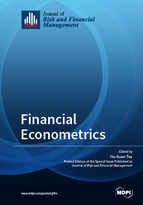Financial Econometrics
A special issue of Journal of Risk and Financial Management (ISSN 1911-8074). This special issue belongs to the section "Economics and Finance".
Deadline for manuscript submissions: closed (30 June 2019) | Viewed by 22797
Special Issue Editor
Interests: econometric methods; financial econometrics; risk management
Special Issues, Collections and Topics in MDPI journals
Special Issue Information
Dear Colleagues,
This Special Issue is concerned with the econometric analysis of financial data, both methodological and applied. The prevalence of large financial data sets and real time updates have opened up new developments in the area of financial econometrics. This issue welcomes studies on aspects of volatility modelling, large dimension financial data, high-frequency trading and data analysis, forecasting of asset returns, financial bubbles and contagion, financial engineering, nonlinear financial time series analysis, long memory time series, and analysis of tail risks and extreme events. Papers for this issue may focus on the econometric study of new financial markets, new financial products and frontier development of econometric methods for financial data.
Prof. Dr. Yiu-Kuen TseGuest Editor
Manuscript Submission Information
Manuscripts should be submitted online at www.mdpi.com by registering and logging in to this website. Once you are registered, click here to go to the submission form. Manuscripts can be submitted until the deadline. All submissions that pass pre-check are peer-reviewed. Accepted papers will be published continuously in the journal (as soon as accepted) and will be listed together on the special issue website. Research articles, review articles as well as short communications are invited. For planned papers, a title and short abstract (about 100 words) can be sent to the Editorial Office for announcement on this website.
Submitted manuscripts should not have been published previously, nor be under consideration for publication elsewhere (except conference proceedings papers). All manuscripts are thoroughly refereed through a single-blind peer-review process. A guide for authors and other relevant information for submission of manuscripts is available on the Instructions for Authors page. Journal of Risk and Financial Management is an international peer-reviewed open access monthly journal published by MDPI.
Please visit the Instructions for Authors page before submitting a manuscript. The Article Processing Charge (APC) for publication in this open access journal is 1400 CHF (Swiss Francs). Submitted papers should be well formatted and use good English. Authors may use MDPI's English editing service prior to publication or during author revisions.
Keywords
- Volatility modelling
- High-frequency financial data
- Financial time series
- Forecasting asset returns
- Tail risks and jump risks
- Financial analytics and trading strategies
- Financial bubbles and contagion





